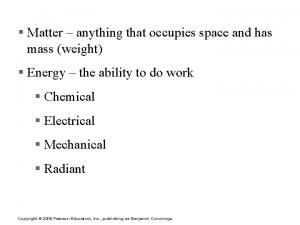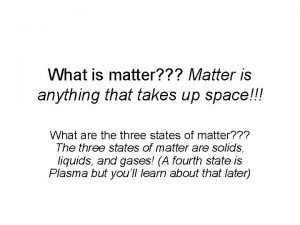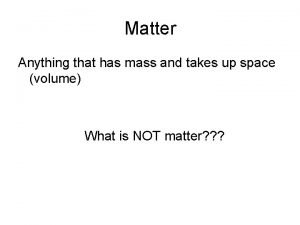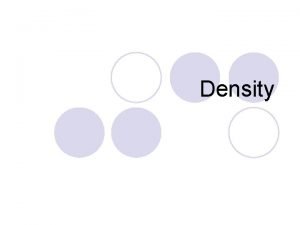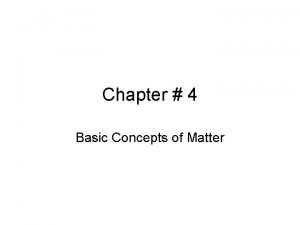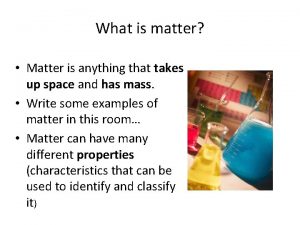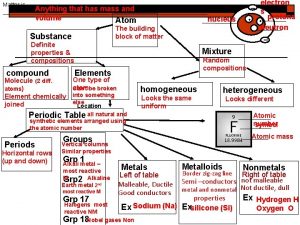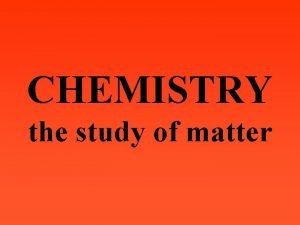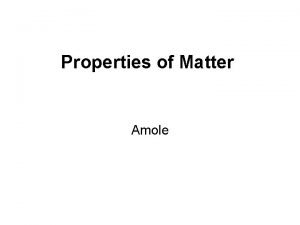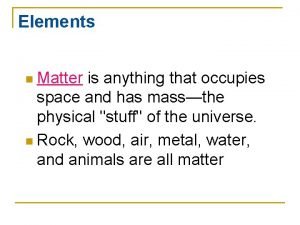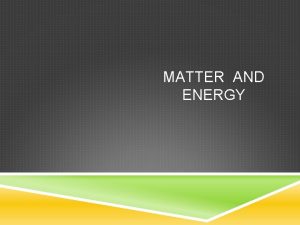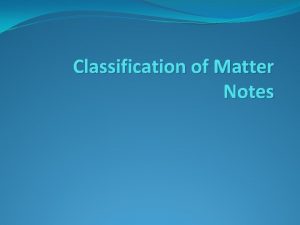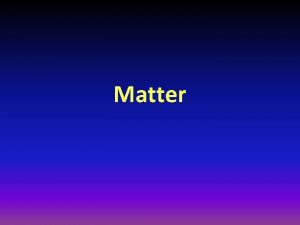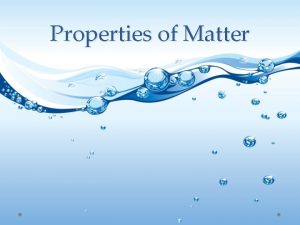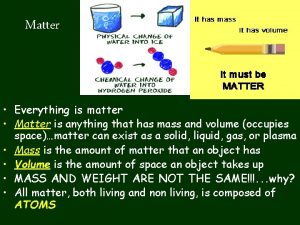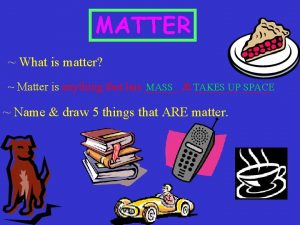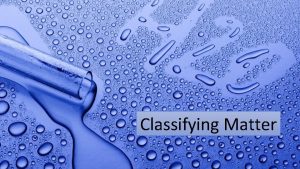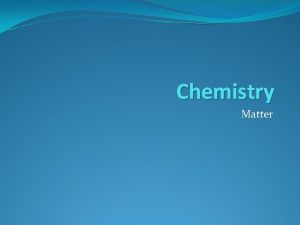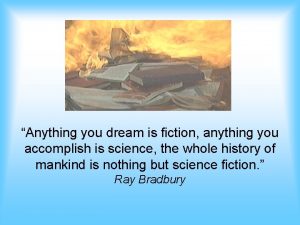Matter 1 What is matter Matter is anything
























- Slides: 24

Matter 1 What is matter? • Matter is anything that takes up space and has mass. • Matter doesn’t have to be visible—even air is matter. Everything in this photo is matter.

Matter 1 States of Matter • There are three familiar states of matter— solid, liquid, and gas. • A fourth state of matter known as plasma occurs at extremely high temperatures. Plasma is found in stars, lightning, Click image to view movie. and neon lights.

Matter 1 Solids • A solid is matter with a definite shape and volume. • A solid does not take the shape of a container in which it is placed. This is because the particles of a solid are packed closely together.

Matter 1 Liquids • A liquid is matter that has a definite volume but no definite shape. • Liquid takes the shape of the container. • The volume of a liquid, however, is the same no matter what the shape of the container.

Matter 1 Free to Move • The particles in a liquid move more freely than the particles in a solid. • The particles in a liquid have enough energy to move out of their fixed positions but not enough energy to move far apart.

Matter 1 Viscosity • Some liquids flow more easily than others. • A liquid’s resistance to flow is known as the liquid’s viscosity. • The slower a liquid flows, the higher its viscosity is. • For many liquids, viscosity increases as the liquid becomes colder.

Matter 1 Gases • Gas is matter that does not have a definite shape or volume. • The particles in gas are much farther apart than those in a liquid or solid. • Gas particles move at high speeds in all directions.

Section Check 1 Question 1 What state of matter is shown in this illustration? A. gas B. liquid C. plasma D. solid

Section Check 1 Answer The answer is A. Particles in a gas are much farther apart than those in a liquid or solid.

Section Check 1 Question 3 Which is composed of particles that have enough energy to move past each other but not enough to break away from each other? A. ice cube B. lemonade C. oxygen D. water vapor

Section Check 1 Answer The answer is B. Lemonade is a liquid. Particles in a liquid stay close together although they are free to move past each other.

Changes of State 2 Thermal Energy and Heat Energy • The total kinetic energy of all the particles in a sample of matter is called thermal energy. • Thermal energy, an extensive property, depends on the number of particles in a substance as well as the amount of energy each particle has.

Changes of State 2 Melting • The change from the solid state to the liquid state is called melting. • The temperature at which a substance changes from a solid to a liquid is called the melting point. • The melting point of water is 0°C.

Changes of State 2 Freezing • The change from the liquid state to the solid state is called freezing. • The temperature at which a substance changes from the liquid state to the solid state is called the freezing point.

Changes of State 2 Changes Between the Liquid and Gas States—Vaporization • Vaporization that takes place at the surface of a liquid is called evaporation. • Evaporation, which occurs at temperatures below the boiling point, explains how puddles dry up.

Changes of State 2 Location of Molecules • It takes more than speed for water molecules to escape the liquid state. • During evaporation, these faster molecules also must be near the surface, heading in the right direction, and they must avoid hitting other water molecules as they leave.

Changes of State 2 Condensation • As a gas cools, its particles slow down. • When particles move slowly enough for their attractions to bring them together, droplets of liquid form. • This process, which is the opposite of vaporization, is called condensation.

Changes of State 2 Condensation • In the same way, water vapor in the atmosphere condenses to form the liquid water droplets in clouds. • When the droplets become large enough, the can fall to the ground as rain.

Changes of State 2 Changes Between the Solid and Gas States • Some substances can change from the solid state to the gas state without ever becoming a liquid. • During this process, known as sublimation, the surface particles of the solid gain enough energy to become a gas. • One example of a substance that undergoes sublimation is dry ice.

Section Check 2 Question 1 The total kinetic energy of all the particles in a substance is known as _______? A. freezing B. heat C. temperature D. thermal energy

Section Check 2 Answer The answer is D. When you heat a substance, you increase its thermal energy.

Section Check 2 Answer The answer is C. Different substances have different specific heats.

Section Check 2 Question 3 The average kinetic energy of the individual particles in a particular substance is referred to as _______?

Section Check 2 Answer The average kinetic energy of the particles in a substance is its temperature. Since different particles have different amounts of energy in any substance, temperature will be an average measurement.
 Benjamin cummings
Benjamin cummings Ionized matter
Ionized matter 7 diatomic elements
7 diatomic elements Matter vs mass
Matter vs mass Matter anything that
Matter anything that Matter is anything that...
Matter is anything that... Matter is defined as anything that
Matter is defined as anything that Matter anything that
Matter anything that Anything that occupies space
Anything that occupies space Matter is anything that:
Matter is anything that: Anything that has mass and takes up space
Anything that has mass and takes up space Buoyancy defintion
Buoyancy defintion Defintion of matter
Defintion of matter Matter is anything that has mass and volume
Matter is anything that has mass and volume Matter anything that
Matter anything that No matter anything
No matter anything Matter is anything that has mass
Matter is anything that has mass Matter is anything that has and takes up
Matter is anything that has and takes up Matter anything that
Matter anything that Anything that occupies space
Anything that occupies space Matter anything that takes up space
Matter anything that takes up space Matter is anything that
Matter is anything that Matter anything that
Matter anything that Anything that has mass and occupies space
Anything that has mass and occupies space What is white matter made of
What is white matter made of
